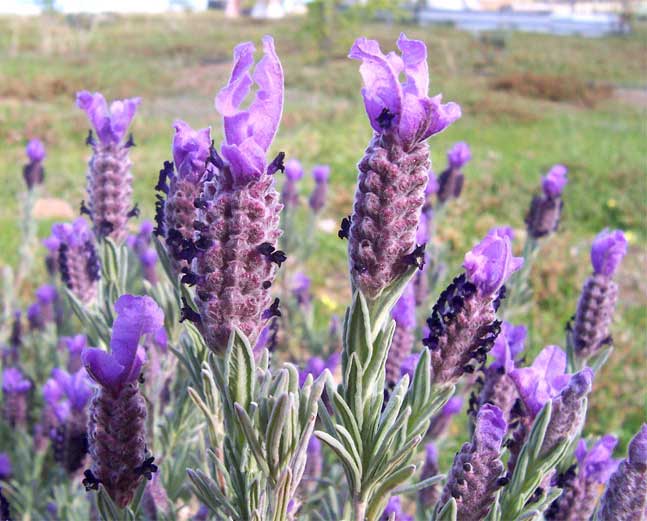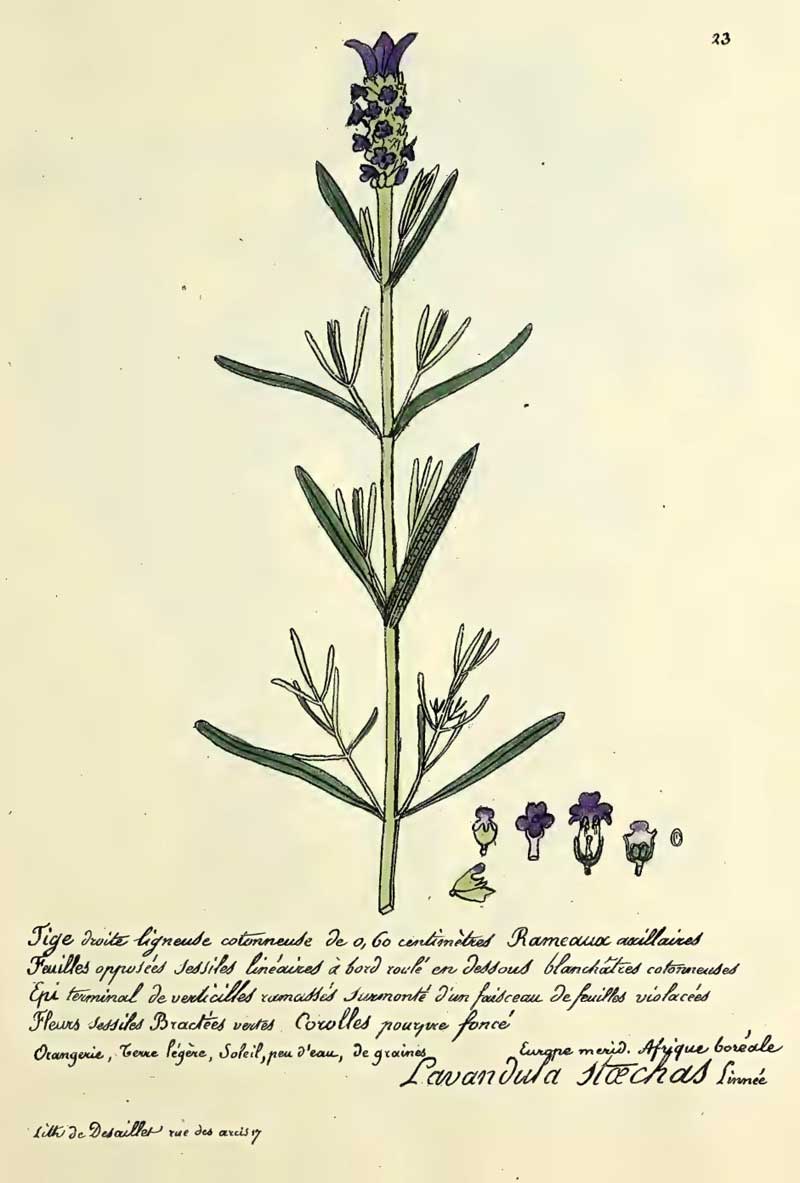
Lavandula stoechas (*)
Classification System: APG IV
Superregnum: Eukaryota
Regnum: Plantae
Cladus: Angiosperms
Cladus: Eudicots
Cladus: Core eudicots
Cladus: Asterids
Cladus: Lamiids
Ordo: Lamiales
Familia: Lamiaceae
Subfamilia: Nepetoideae
Tribus: Ocimeae
Subtribus: Lavandulinae
Genus: Lavandula
Subgenus: L. subg. Lavandula
Sectio: L. sect. Stoechas
Species: Lavandula stoechas
Subspecies: L. s. subsp. luisieri – L. s. subsp. stoechas
Name
Lavandula stoechas L., Sp. Pl.: 573 (1753).
Synonyms
Homotypic
Stoechas officinarum Mill., Gard. Dict. ed. 8: n.° 1 (1768).
Distribution
Native distribution areas:
Continental: Europe
Regional: Southwestern Europe
Baleares, Corse, France, Portugal, Sardegna, Spain.
Regional: Southeastern Europe
Greece, Italy, Kriti, Sicilia, Turkey-in-Europe.
Continental: Africa
Regional: Northern Africa
Algeria, Morocco, Tunisia.
Regional: Macaronesia
Canary Islands (introduced).
Continental: Asia-Temperate
Regional: Western Asia
Cyprus, East Aegean Islands, Lebanon-Syria, Palestine, Turkey.
Continental: Australasia
Regional: New Zealand
New Zealand South (introduced).
References: Brummitt, R.K. 2001. TDWG – World Geographical Scheme for Recording Plant Distributions, 2nd Edition

References
Primary references
Linnaeus, C. 1753. Species Plantarum. Tomus II: 573. Reference page.
Additional references
Dobignard, A. & Chatelain, C. 2012. Index synonymique de la flore d'Afrique du Nord. Volume 4: Dicotyledoneae: Fabaceae – Nymphaeaceae. Conservatoire et jardin botaniques, Genève, ISBN 978-2-8277-0126-1, 431 pp. PDF Reference page.
Links
Govaerts, R. et al. 2022. Lavandula stoechas in World Checklist of Selected Plant Families. The Board of Trustees of the Royal Botanic Gardens, Kew. Published online. Accessed: 2022 May 21. Reference page.
Hassler, M. 2022. Lavandula stoechas. World Plants: Synonymic Checklists of the Vascular Plants of the World In: Roskovh, Y., Abucay, L., Orrell, T., Nicolson, D., Bailly, N., Kirk, P., Bourgoin, T., DeWalt, R.E., Decock, W., De Wever, A., Nieukerken, E. van, Zarucchi, J. & Penev, L., eds. 2022. Species 2000 & ITIS Catalogue of Life. Published online. Accessed: 2022 May 21. Reference page.
Tropicos.org 2022. Lavandula stoechas. Missouri Botanical Garden. Published online. Accessed: 21 May 2022.
International Plant Names Index. 2022. Lavandula stoechas. Published online. Accessed: May 21 2022.
USDA, ARS, Germplasm Resources Information Network. Lavandula stoechas in the Germplasm Resources Information Network (GRIN), U.S. Department of Agriculture Agricultural Research Service.
Vernacular names
Deutsch: Schopf-Lavendel
Ελληνικά, Κυπριακά: Λεβάντα η στοιχάς, Μυροφόρα
español: Cantueso
suomi: Tupsulaventeli
magyar: Füzéres levendula, bóbitás levendula
italiano: Lavanda selvatica
Mirandés: tomielho
português: Rosmaninho
sardu: Ispìgula areste
Türkçe: Karabaş otu
Lavandula stoechas, the Spanish lavender or topped lavender (U.S.) or French lavender (U.K.),[1] is a species of flowering plant in the family Lamiaceae, occurring natively in several Mediterranean countries, including France, Spain, Portugal, Italy and Greece.[2]
Description
It is an evergreen shrub that usually grows to between 30 and 100 cm tall and occasionally up to 2 m (6.5 ft) tall in the subspecies L. stoechas subsp. luisieri. Its leaves are 1–4 cm long, greyish and tomentose. The inflorescence is crowned by a mass of purple elongated ovoid bracts about 5 cm long. Lower flowers form a tight rectangle in cross-section. The upper of the five teeth has a wrong-heart-shaped appendage. The crown is blackish-violet, up to 8 mm long and indistinct two-lipped.
The flowers, which appear in late spring and early summer, are pink to purple, produced on spikes 2 cm long at the top of slender, leafless stems 10–30 cm (4–12 in) long; each flower is subtended by a bract 4–8 mm long. At the top of the spike are a number of much larger, sterile bracts (no flowers between them), 10–50 mm long and bright lavender purple (rarely white). It blooms in spring and early summer, from the month of March in its native habitat, depending on the climate in which it grows.[3]
The Latin specific epithet stoechas comes from the Greek stoichas meaning “in rows”. It is also the Greek name for this species.[4]
Subspecies
The recognised subspecies are:
L. stoechas pedunculata, the common type specific plant, once taxonomically considered L. pedunculata. There is considerable variation in this subspecies, and it may be split into a number of distinct forms. It is native to many coastal regions of the Mediterranean, with some populations on the Atlantic coasts of Morocco and Spain.[3]
L. stoechas luisieri, which has petals much less interconnected. It is found mainly in Portugal and adjacent regions of Spain.[3]
L. stoechas subsp. sampaiana[5]
L. stoechas subsp. lusitanica[5]
L. stoechas subsp. atlantica[5]
L. stoechas subsp. maderensis[5]
L. stoechas subsp. cariensis[5]
Cultivation
This species is more tender than common lavender (Lavandula angustifolia), being less frost-resistant, but harsher and more resinous in its oils. Like other lavenders, it is associated with hot, dry, sunny conditions in alkaline soils. However, it tolerates a range of situations, though it may be short-lived. Hardy down to −10 °C (14 °F)[1] (USDA zones 8–10).
The following cultivars have won the Royal Horticultural Society's Award of Garden Merit:-[6]
'Ballerina'[7]
'Pretty Polly' [8]
'Willow Vale'[9]
Other uses
The flowers are used in aromatherapy to prepare infusions and essential oils that contain ketones (d-camphor and d-fenchone) and alcohols (borneol and terpineol).[10]
Invasive species
Since its introduction into Australia, it has become an invasive species, widely distributed within the continent. It has been declared a noxious weed in Victoria since 1920. It also is regarded as a weed in parts of Spain.[11]
References
RHS A-Z encyclopedia of garden plants. United Kingdom: Dorling Kindersley. 2008. p. 1136. ISBN 978-1405332965.
Dankwart Seidel: Flowers on the Mediterranean. Determine without fail with the 3-check . BLV, Munich 2002, ISBN 3-405-16294-7
Upson and Andrews; The Genus Lavandula
Harrison, Lorraine (2012). RHS Latin for Gardeners. United Kingdom: Mitchell Beazley. ISBN 978-1845337315.
Upson, Tim (2004) [1st pub. 2002]. "Chapter 2: The taxonomy of the genus Lavendula L.". In Lis-Balchin, Maria (ed.). Lavender: The genus Lavendula. London: Taylor & Francis. ISBN 0-203-21652-0.
"AGM Plants - Ornamental" (PDF). Royal Horticultural Society. July 2017. p. 59. Retrieved 19 March 2018.
"Lavandula 'Ballerina'". RHS. Retrieved 19 March 2020.
"Lavandula 'Pretty Polly'". RHS. Retrieved 1 October 2020.
"RHS Plant Selector - Lavandula 'Willow Vale'". Retrieved 23 February 2020.
Bown, Deni (2002). The Royal Horticultural Society Encyclopedia of Herbs and Their Uses (Revised ed.). DK. p. 257. ISBN 1-4053-0059-0.
Csurches S., Edwards R.; National Weeds Program, Potential Environmental Weeds in Australia, Candidate Species for Preventative Control; Queensland Department of Natural Resources. January 1998 ISBN 0-642-21409-3
Retrieved from "http://en.wikipedia.org/"
All text is available under the terms of the GNU Free Documentation License

